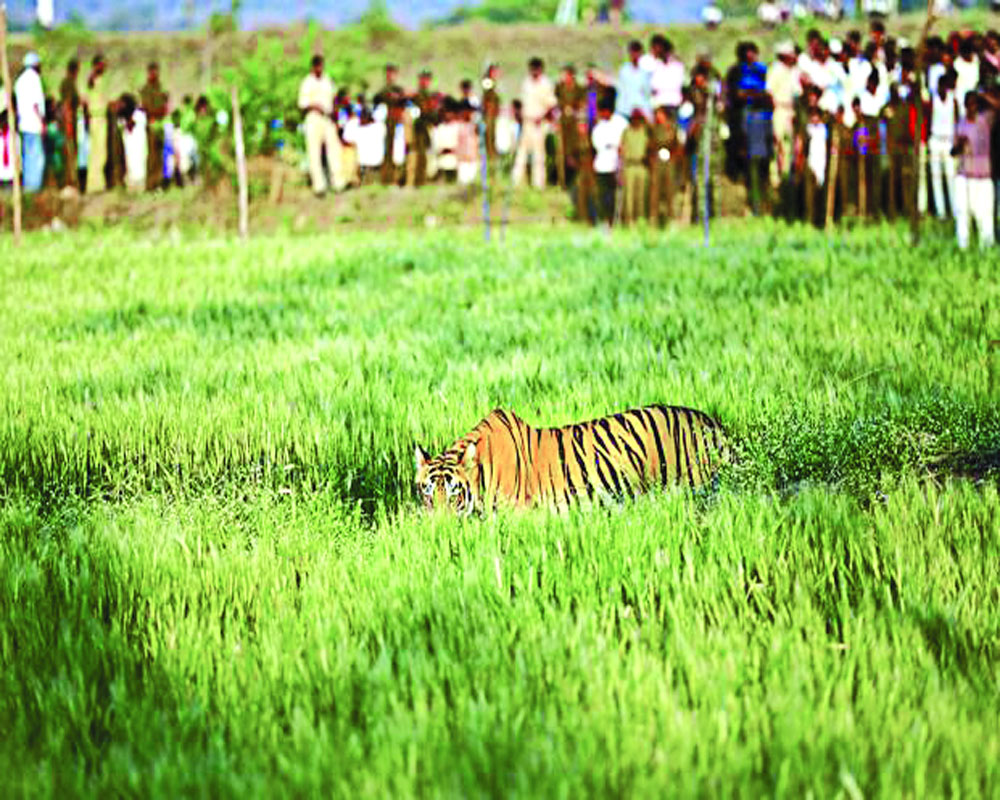With sugarcane harvest approaching and controversy over killing of Maharashtra’s Avni tigress in mind, forest officials in the Tarai Belt of Uttar Pradesh are going from village to village, creating awareness on essential dos and dont’s on how people should avoid conflict with predators like leopards and striped big cats.
People have been told to stay in group and carry sticks and torches while going to forests for defecation or other reasons.
In case anyone is alone, he should play radio on the way so that the big cats keep distance. They have been asked to keep doors of homes locked at night. Also since, tiger often lift animals at night, the livestock should be properly protected.
“We are also educating locals in identifying the pug marks so that they can avoid confrontation with big cats. Sometimes, hyena is also mistaken for leopards. Also locals are being sensitising that how tigers when left to themselves, invariably avoid confrontation with humans,” said Hemant Kumar, chief conservator of Forest, Gorakhpur in Uttar Pradesh.
Talking about the mitigating efforts being taken in his region, he said circulars in local languages as well as the posters illustrating pugmarks of predators like leopards, tigers and hyena have been distributed to help people identify the animals when venturing in the field. In case they sense its presence, they should inform the officials instead of tackling with the wild animals on their own.
The locals have been provided the numbers of the officials to be contacted.
“At nights people usually sleep outside guarding their pump sets. But we have asked them not to do so as personnel safety is more important. We have also suggested them not to get agitated in case the big cats kill their livestock. The Government provides ample compensation in such cases,” said Kumar, adding there are insurance compensation also.
The villagers are also advised that make noise by beating the drums while entering the field for harvesting the crop will prompt the animal to flee the cropland on its own.
Kumar explained that during winter, tigers prefer to look for easy prey hiding in sugarcane fields. It is only when people surrounds the animal or try to mob or catch its glimpse that the predator attacks in retaliation. It’s advisable to to give way so that the predator goes back to the forests.
As human-tiger conflicts are on increase due to various reasons, experts feel that such ‘do and dont’s’ have become a need of the hour over the years to take the locals in confidence and make them aware about the importance of tigers as a flagship species and the importance for its conservation for the biodiversity surrounding them.
A recent report “Living with the Wild: Mitigating conflict between human and big cat species in Uttar Pradesh” by the Wildlife Trust of India (WTI) and UP Forest Department says it all.
“UP has the second-highest incidence of leopard-related human fatalities as well as tiger attacks on humans, and sees a large number of livestock kills. This is a region of great interest with respect to conflict between humans and large predators,” it said.
As per the report, around 180 cases of conflicts between humans and big cats (tigers, leopards) leading to human deaths and injuries have been recorded between 2000 and 2018 in and around the Dudhwa-Pilibhit Tiger landscape in Uttar Pradesh. Of these, 98 pertained to tigers.
According to the WTI report, tiger attacks occurred largely inside forests or on their fringes (54.79 per cent), while (31.5 per cent) occurred in crop fields, primarily sugarcane. Only a small proportion of attacks (13.7 per cent) were recorded to have occurred within houses or near homes.
Only a small percentage of tiger attacks occurred at greater distances away from the forest edge. The data suggested that most attacks by tigers are due to accidental encounters between humans and tigers, as per the report. Attacks by tigers were higher when people visited forests to collect firewood and other non-timber products (38.6 per cent), people doing odd jobs, sitting, moving, defecating or urinating in the village periphery or fringe forests.
Contrastingly, leopard attacks were mainly concentrated within or near village boundaries (92.1 per cent), with 47.6 per cent of attacks occurring inside houses or near homesteads, 15.87 per cent occurring within village peripheries and 28.6 per cent taking place in agricultural fields. Vivek Menon from WTI summed up in the report by saying that it’s by understanding people, animals and the needs of the twain, and by devising a local settlement of these needs, that the single largest threat to wild animals and people can find resolution.


























